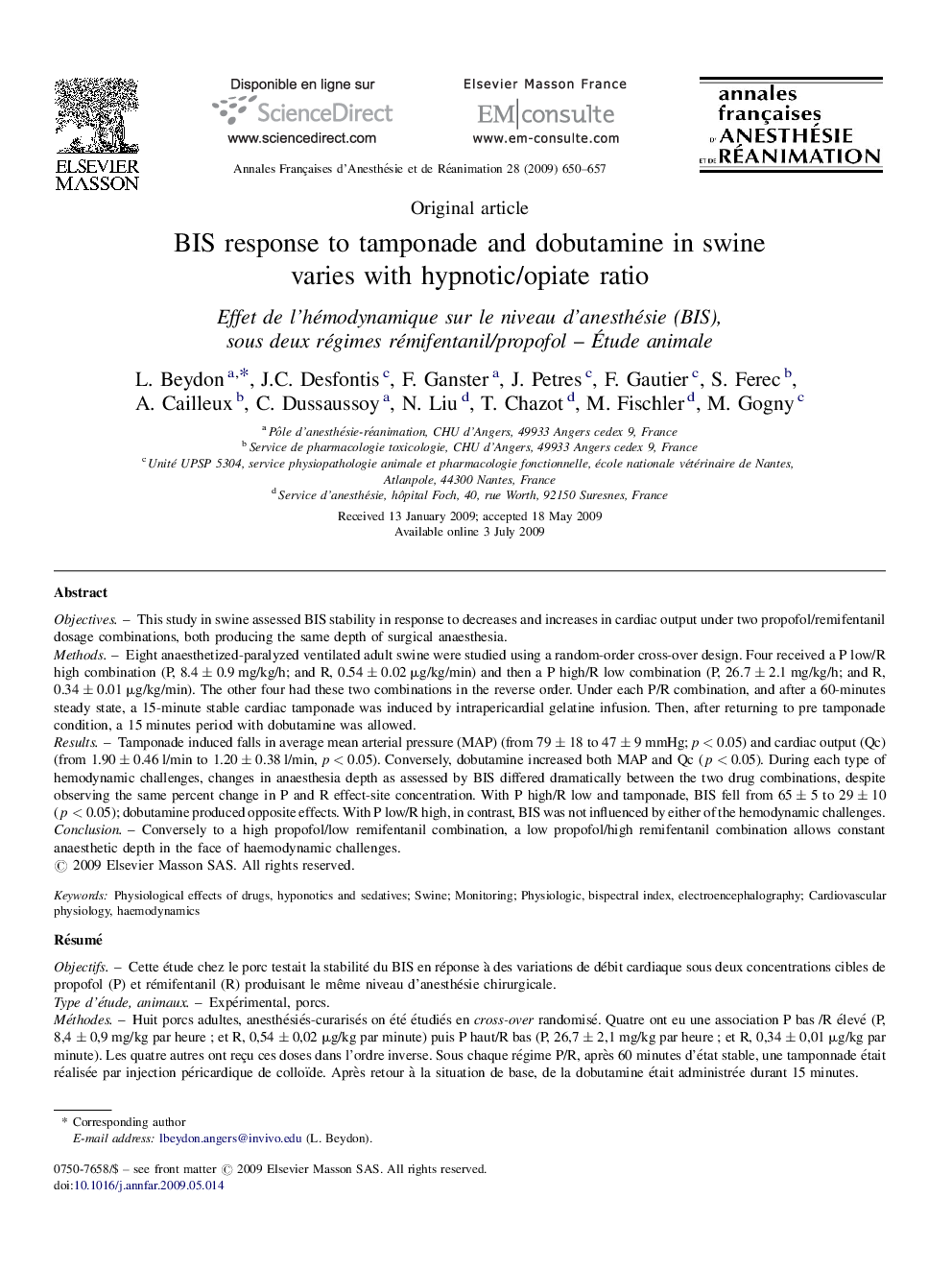| Article ID | Journal | Published Year | Pages | File Type |
|---|---|---|---|---|
| 2746851 | Annales Françaises d'Anesthésie et de Réanimation | 2009 | 8 Pages |
ObjectivesThis study in swine assessed BIS stability in response to decreases and increases in cardiac output under two propofol/remifentanil dosage combinations, both producing the same depth of surgical anaesthesia.MethodsEight anaesthetized-paralyzed ventilated adult swine were studied using a random-order cross-over design. Four received a P low/R high combination (P, 8.4 ± 0.9 mg/kg/h; and R, 0.54 ± 0.02 μg/kg/min) and then a P high/R low combination (P, 26.7 ± 2.1 mg/kg/h; and R, 0.34 ± 0.01 μg/kg/min). The other four had these two combinations in the reverse order. Under each P/R combination, and after a 60-minutes steady state, a 15-minute stable cardiac tamponade was induced by intrapericardial gelatine infusion. Then, after returning to pre tamponade condition, a 15 minutes period with dobutamine was allowed.ResultsTamponade induced falls in average mean arterial pressure (MAP) (from 79 ± 18 to 47 ± 9 mmHg; p < 0.05) and cardiac output (Qc) (from 1.90 ± 0.46 l/min to 1.20 ± 0.38 l/min, p < 0.05). Conversely, dobutamine increased both MAP and Qc (p < 0.05). During each type of hemodynamic challenges, changes in anaesthesia depth as assessed by BIS differed dramatically between the two drug combinations, despite observing the same percent change in P and R effect-site concentration. With P high/R low and tamponade, BIS fell from 65 ± 5 to 29 ± 10 (p < 0.05); dobutamine produced opposite effects. With P low/R high, in contrast, BIS was not influenced by either of the hemodynamic challenges.ConclusionConversely to a high propofol/low remifentanil combination, a low propofol/high remifentanil combination allows constant anaesthetic depth in the face of haemodynamic challenges.
RésuméObjectifsCette étude chez le porc testait la stabilité du BIS en réponse à des variations de débit cardiaque sous deux concentrations cibles de propofol (P) et rémifentanil (R) produisant le même niveau d’anesthésie chirurgicale.Type d’étude, animauxExpérimental, porcs.MéthodesHuit porcs adultes, anesthésiés-curarisés on été étudiés en cross-over randomisé. Quatre ont eu une association P bas /R élevé (P, 8,4 ± 0,9 mg/kg par heure ; et R, 0,54 ± 0,02 μg/kg par minute) puis P haut/R bas (P, 26,7 ± 2,1 mg/kg par heure ; et R, 0,34 ± 0,01 μg/kg par minute). Les quatre autres ont reçu ces doses dans l’ordre inverse. Sous chaque régime P/R, après 60 minutes d’état stable, une tamponnade était réalisée par injection péricardique de colloïde. Après retour à la situation de base, de la dobutamine était administrée durant 15 minutes.RésultatsLa tamponnade réduisant la PA moyenne (PAM) (de 79 ± 18 à 47 ± 9 mmHg ; p < 0,05) et le débit cardiaque (DC) (de 1,90 ± 0,46 l/min à 1,20 ± 0,38 l/min, p < 0,05). Inversement, la dobutamine augmentait PAM et DC (p < 0,05). Les réponses en termes de BIS différaient radicalement entre les deux régimes d’administration de P et R, malgré des variations similaires des concentrations plasmatiques de P et R. Sous P haut/R bas et tamponnade, le BIS chutait de 65 ± 5 à 29 ± 10 (p < 0,05) ; la dobutamine produisait l’effet inverse. Sous P bas/R haut, le BIS ne se modifiait, ni sous tamponnade, ni sous dobutamine.ConclusionUn ratio P bas/R haut permet une parfaite stabilité anesthésique en situation hémodynamique altérée, contrairement à la situation P haut/R bas.
